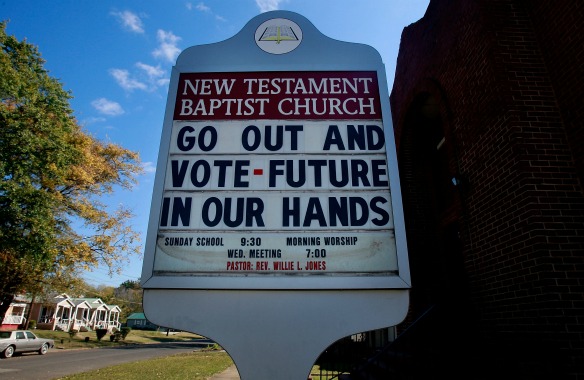
With the inauguration over, along with the 2012 election, it’s time to count casualties. The first, as in warfare, is truth. A second might be an understanding of who can speak in a democracy.
Misrepresentations abounded. Spinmeisters turned the Catholic Church’s right to religious freedom—including its right to practice what it preaches—into a war over contraception. The church voiced alarm at a Health and Human Services mandate issued under the new health care law. Under the mandate the church need not pay for health insurance coverage of contraception and sterilization for the church secretary but must pay for such coverage for employees of church organizations that serve more than their co-religionists, for example in a church-run school, hospital, or food pantry. On February 1, the administration simplified its position of what constitutes a religious ministry but did not completely satisfy concerns related to conscience rights.
When religious freedom became a political football, people criticized the healing church but not the well-heeled abortion lobby fighting it. That’s a far cry from George Washington who once declared that “the conscientious scruples of all men should be treated with great delicacy and tenderness: and it is my wish and desire, that the laws may always be … extensively accommodated to them.”
IRS rules on what a tax exempt organization can do when it comes to political activity often became skewed in the public eye. The reality is that a churchman, even a bishop, does not give up his civil rights when he dons a Roman collar. He can have and voice an opinion about the issues of the day.
The church and its leaders have a right to participate in the public square. Like others in the public arena, church leaders rejoiced in some outcomes and grieved over others. In Massachusetts, voters rejected physician-assisted suicide, taking a stand for life in a vulnerable stage, when weakened by illness and/or old age. In Maryland, voters passed the Dream Act, to give educational opportunities to young undocumented immigrants educated in U.S. schools. The church’s compassion for the weak, especially children, showed in both instances.
There were sad moments. In California, an effort to outlaw the death penalty was unsuccessful. Church leaders from the pope on down have decried the use of the death penalty for some years now. Four states—Maine, Minnesota, Maryland and Washington—voted to reject the definition of marriage as the union of one man and one woman. The church opposed the redefinition of marriage for numerous reasons, including the fact that marriage is the only institution that unites children with their parents.
The church’s participation in the public sphere is not new. Nearly every major social movement in our country has involved the church, and the church has garnered criticism for political involvement. In the 1940’s there was criticism of Msgr. John A. Ryan of the U.S. bishops’ conference. He urged social reform and critics gave him the moniker “Msgr. New Deal.”
A few decades later, clergy were active in the civil rights movement. The greatest hero of that movement, Martin Luther King Jr., held the title “Reverend” because he was a Baptist minister. Joining him were Rabbi Abraham Heschel, who walked with King on the march to Selma, and Rabbi David Teitelbaum, who worked on the March 1965 voter registration drive of African Americans.
Religious sisters and lay ministers have joined efforts for the poor here and abroad. Some gave their lives, including Maryknoll’s Sisters Ita Ford and Maura Clarke, Ursuline Sister Dorothy Kazel, and laywomen Jean Donovan, murdered in El Salvador in 1980.* In 2005, Notre Dame de Namur Sister Dorothy Stang was slain in the Amazon in Brazil.
The efforts of religious groups in the last election reflect the American tradition of religious leaders speaking out. In the new information age, their voices may have seemed louder and their reach farther, but they followed democracy’s way where good citizens engage in the political process. And true to politics, some people thought the religious figures were right on, and some thought they were way off. That’s how it goes. Jesus had a similar problem.
*Correction: This sentence has been revised to note the women died in 1980, not 1983 as originally stated.
